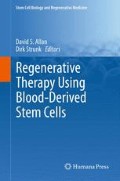Abstract
The first successful umbilical cord blood (UCB) transplant in 1989 on a patient with Fanconi anemia sparked the creation of cord blood banks worldwide, including more than 100 public banks and nearly 500,000 banked units. Although cord blood units have been historically collected and stored for use in hematopoietic transplantation, there is increasing attention regarding nonhematopoietic cells within cord blood units and their important regenerative functions, making the prospect of using UCB for vascular repair or regenerative therapy most exciting. In this chapter, we provide an outline of various cell types with regenerative function that are present in UCB units and discuss the potential role of using banked cord blood cells for regenerative therapy.
Access this chapter
Tax calculation will be finalised at checkout
Purchases are for personal use only
References
Ahmadbeigi N, Seyedjafari E, Gheisari AA, Omidkhoda A, Soleimani M (2010) Surface expression of CXCR4 in unrestricted somatic stem cells and its regulation by growth factors. Cell Biol Int 34:687–692
Asahara T, Murohara T, Sullivan A et al (1997) Isolation of putative progenitor endothelial cells for angiogenesis. Science 275:964–967
Atkins (2010) for the treatment of multiple sclerosis. Bone Marrow Transplant 45:1671–1681
Au P, Daheron LM, Duda DG et al (2008) Differential in vivo potential of endothelial progenitor cells from human umbilical cord blood and adult peripheral blood to form functional long-lasting vessels. Blood 111:1302–1305
Brody AR, Salazar KD, Lankford SM (2010) Mesenchymal stem cells modulate lung injury. Proc Am Thorac Soc 7:130–133
Corselli M, Parodi A, Mogni M et al (2008) Clinical scale ex vivo expansion of cord blood-derived outgrowth endothelial progenitor cells is associated with high incidence of karyotype aberrations. Exp Hematol 36:340–349
Delorme B, Basire A, Gentile C et al (2005) Presence of endothelial progenitor cells, distinct from mature endothelial cells, within human CD146+ blood cells. Thromb Haemost 94:1270–1279
Duijvestein M, Vos AC, Roelofs H et al (2010) Autologous bone marrow-derived mesenchymal stromal cell treatment for refractory luminal Crohn’s disease: results of a phase I study. Gut 59:1662–1669
Gratwohl A, Baldomero H, Schwendener A et al (2009) The EBMT activity survey 2007 with focus on allogeneic HSCT for AML and novel cellular therapies. Bone Marrow Transplant 43:275–291
Gratwohl A, Baldomero H (2010) European survey on clinical use of cord blood for hematopoietic and non-hematopoietic indications. Transfus Apher Sci 42:265–275
Greschat S, Schira J, Kury P et al (2008) Unrestricted somatic stem cells from human umbilical cord blood can be differentiated into neurons with a dopaminergic phenotype. Stem Cells Dev 17:221–232
Jansen BJ, Gilissen C, Roelofs H et al (2010) Functional differences between mesenchymal stem cell populations are reflected by their transcriptome. Stem Cells Dev 19:481–490
Kluth SM, Buchheiser A, Houben AP et al (2010) DLK-1 as a marker to distinguish unrestricted somatic stem cells and mesenchymal stromal cells in cord blood. Stem Cells Dev 19:1471–1483
Kogler G, Sensken S, Airey JA et al (2004) A new human somatic stem cell from placental cord blood with intrinsic pluripotent differentiation potential. J Exp Med 200:123–135
Liedtke S, Buchheiser A, Bosch J et al (2010) The HOX Code as a “biological fingerprint” to distinguish functionally distinct stem cell populations derived from cord blood. Stem Cell Res 5:40–50
Lin Y, Weisdorf DJ, Solovey A, Hebbel RP (2000) Origins of circulating endothelial cells and endothelial outgrowth from blood. J Clin Invest 105:71–77
Lin Y, Chang L, Solovey A, Healey JF, Lollar P, Hebbel RP (2002) Use of blood outgrowth endothelial cells for gene therapy for hemophilia A. Blood 99:457–462
Marmont AM, Burt RK (2008) Hematopoietic stem cell transplantation for systemic lupus erythematosus, the antiphospholipid syndrome and bullous skin diseases. Autoimmunity 41:639–647
Murohara T (2001) Therapeutic vasculogenesis using human cord blood-derived endothelial progenitors. Trends Cardiovasc Med 11:303–307
Murohara T (2010) Cord blood derived early-outgrowth endothelial cells. Microvasc Res 79:174–177
Nagano M, Kimura K, Yamashita T et al (2010) Hypoxia responsive mesenchymal stem cells derived from human umbilical cord blood are effective for bone repair. Stem Cells Dev 19:1195–1210
Nishiyama N, Miyoshi S, Hida N et al (2007) The significant cardiomyogenic potential of human umbilical cord blood-derived mesenchymal stem cells in vitro. Stem Cells 25:2017–2024
Peichev M, Naiyer AJ, Pereira D et al (2000) Expression of VEGFR-2 and AC133 by circulating human CD34+ cells identifies a population of functional endothelial precursors. Blood 95:952–958
Shaw BE, Veys P, Pagliuca A et al (2009) Recommendations for a standard UK approach to incorporating umbilical cord blood into clinical transplantation practice: conditioning protocols and donor selection algorithms. Bone Marrow Transplant 44:7–12
Siepe M, Akhyari P, Lichtenberg A, Schlensak C, Beyersdorf F (2008) Stem cells used for cardiovascular tissue engineering. Eur J Cardiothorac Surg 34:242–247
Sundin M, Barrett AJ, Ringdén O et al (2009) HSCT recipients have specific tolerance to MSC but not to the MSC donor. J Immunother 32:755–764
Vanneaux V, El-Ayoubi F, Delmau C et al (2010) In vitro and in vivo analysis of endothelial progenitor cells from cryopreserved umbilical cord blood: are we ready for clinical application? Cell Transplant 19:1143–1155
Wexler SA, Donaldson C, Denning-Kendall P, Rice C, Bradley B, Hows JM (2003) Adult bone marrow is a rich source of human mesenchymal ‘stem’ cells but umbilical cord and mobilized adult blood are not. Br J Haematol 121:368–374
Wu LK, Tokarew JM, Chaytor JL et al (2011) Carbohydrate-mediated inhibition of ice recrystallization in cryopreserved human umbilical cord blood. Carbohydrate Res 346:86–93
Author information
Authors and Affiliations
Corresponding author
Editor information
Editors and Affiliations
Rights and permissions
Copyright information
© 2012 Springer Science+Business Media, LLC
About this chapter
Cite this chapter
Klowak, J., Chung, Y., Allan, D.S. (2012). Cord Blood Banking for Regenerative Therapy. In: Allan, D., Strunk, D. (eds) Regenerative Therapy Using Blood-Derived Stem Cells. Stem Cell Biology and Regenerative Medicine. Humana Press. https://doi.org/10.1007/978-1-61779-471-1_12
Download citation
DOI: https://doi.org/10.1007/978-1-61779-471-1_12
Published:
Publisher Name: Humana Press
Print ISBN: 978-1-61779-470-4
Online ISBN: 978-1-61779-471-1
eBook Packages: Biomedical and Life SciencesBiomedical and Life Sciences (R0)

